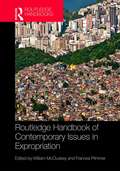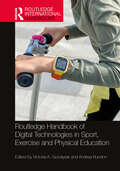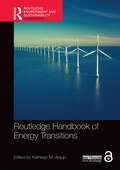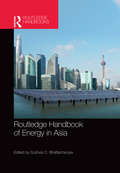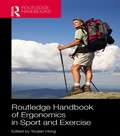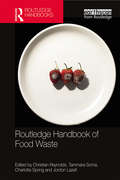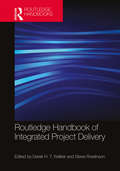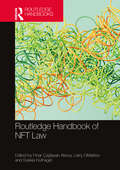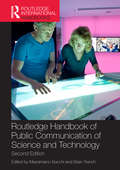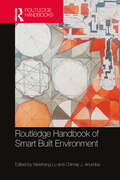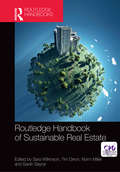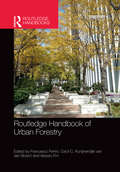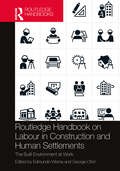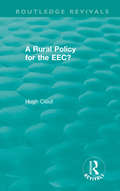- Table View
- List View
Routledge Companion to Real Estate Investment
by Richard K. Green Bryan D. MacGregor Rainer SchulzReal estate represents an increasingly significant global asset class and its distinctive characteristics must be understood by investors and researchers. <P><P>The Routledge Companion to Real Estate Investment provides an authoritative overview of the real estate asset class. The Companion focuses on the current academic research and its relevance for practical applications. The book is divided into four parts, each containing specially written chapters by international experts in the relevant field. The contributors cover the institutional context for real estate investment, the main players in real estate investment, real estate appraisal and performance measurement, and real estate portfolios and risk management. <P><P>This Companion provides a comprehensive reference for students, academics and professionals studying, researching and working in real estate investment, finance and economics.
Routledge Handbook of Collaboration in Construction
by Lauri Koskela Sina Moradi Ole Jonny Klakegg Kirsi Aaltonen Kalle KähkönenThis innovative Handbook aims to look at the logic, various dimensions, and implications of collaboration in construction. It opens with a conceptualization of collaboration and its accompanying terms (i.e., cooperation and coordination) and continues with chapters in Part I which discuss the theoretical grounds of collaboration between individuals and organizations from the viewpoints of an impressive variety of relevant disciplines including organizational science; anthropology; law; economics; design; and production.This is followed by discussions of the essence and value of collaboration in construction in Part II through explaining the role of collaborative project delivery methods and their benefits in advancing collaboration, describing the competency profile of project managers for collaborative construction, explaining key drivers and barriers of collaboration in construction, and explaining practices as well as challenges of measuring collaboration in construction.Then, in Part III, case projects are employed to explain the benefits of collaboration in different levels of team, project, and business, to discuss the role and impact of collaboration on site and bridging the divide between construction and facility management, to discuss the role of digitalization in facilitating and advancing collaboration, to explain collaboration in decision making, to present examples of collaborative visual management, and to outline the implications of stakeholders' early involvement and collaboration for project success. Finally, consideration is given to the future of collaboration in construction to conclude the book.This Handbook is key reading for a broad ranging audience within the fields of construction, project, infrastructure and engineering management, organisational science, economics, and business management.
Routledge Handbook of Construction Project Procurement and Delivery: Fundamentals, Trends and Imperatives
by Mohan M. KumaraswamyThis Handbook provides the knowledge needed to design and deploy proactive construction project procurement and delivery systems based on essentials while addressing emerging construction industry imperatives in order to boost overall performance.Section 1 of the Handbook provides an overview, while Section 2 provides the fundamentals with fresh insights into the building blocks and trends in performance-linked procurement and delivery, including procurement strategies and commercial priorities, project briefs and management plans, design management, stakeholder management, risk management, ethics and professionalism, team building, information and knowledge management, digital aids, conflict, claims and dispute management, collaborative contracting, relationship-based teamworking and linking to built asset management.Section 3 explores and expands on specific trends, including sub-contractor selection, Building Information Modelling (BIM) in project cost management; off-site and modern methods of construction; 4IR/5IR technologies; and constructing for the circular economy, supply chain resilience and social value imperatives in this domain.While other books describe standard processes or focus on specific strategies such as design and build, target cost contracting or integrated project delivery, this Handbook presents the fundamentals of such processes and protocols together with invited specialist insights into growing trends and imperatives in holistic procurement and delivery. Those who could benefit from this Handbook include academics, researchers, postgraduate students, policy makers and administrators, managers in both public and private sectors involved with planning and overseeing construction project procurement and/or delivery and undergraduates looking for a balanced introduction and useful insights into what is critical to the success of construction projects, organisations and the industry itself.
Routledge Handbook of Contemporary Issues in Expropriation
by Frances Plimmer William McCluskeyThe Routledge Handbook of Contemporary Issues in Expropriation reviews the contemporary major issues involving expropriation (eminent domain/compulsory purchase) in an international context. Expropriation is a right reserved to all governments, and, thus, it has an impact on all societies. This book, the first of its kind, considers the essential issues from the point of view of both developing and developed countries, and their needs for major infrastructure projects. The content covers major issues, principles and policies and includes the experiences of and examples from different countries and regions, including Australia, Asia, China, Europe, India and the USA. Rather than providing an in-depth examination of individual countries’ legal systems, the book focuses on international issues, and also provides a reflection on how national experiences can be related to global needs. Key themes include: Nature and quantum of compensation • Land rights and the acquisition of traditional land rights • Issues surrounding ‘public interest’ •Alternatives to expropriation •The future: “good practice”, debate and reform. This handbook is an essential resource for students and researchers in the areas of land policy, land law, property law and rights, and international development.
Routledge Handbook of Digital Technologies in Sport, Exercise and Physical Education (Routledge International Handbooks)
by Victoria A. Goodyear and Andrea BundonThis is the first book to offer in-depth analysis of the use of digital technologies in sport, exercise and physical education; their significance for the relationship between sport, exercise and wider society; and their impact on research in sport, exercise and physical education.Featuring the work of leading researchers from around the world, and drawing on multidisciplinary perspectives including from sociology, pedagogy, psychology and related disciplines, with a strong focus on qualitative, social scientific approaches, this book examines how individuals experience and engage with technology in the context of their physical practices. Exploring key concepts and methodologies, as well looking at how digital technologies are used in practice, this book covers diverse topics including social media, wearables, apps, video software, AI and in the context of teaching, coaching, learning, athlete safeguarding and more.This book is essential reading for any student, researcher, teacher, instructor or coach with an interest in sport, exercise, physical education, psychology, health and the relationships between technology and society.
Routledge Handbook of Energy Transitions (Routledge Environment and Sustainability Handbooks)
by Kathleen M. AraújoThe Routledge Handbook of Energy Transitions draws upon a unique and multidisciplinary network of experts from around the world to explore the expanding field of energy transitions. This Handbook recognizes that considerable changes are underway or are being developed for the modes in which energy is sourced, delivered, and utilized. Employing a sociotechnical approach that accounts for economics and engineering, as well as more cross-cutting factors, including innovation, policy and planning, and management, the volume considers contemporary ideas and practices that characterize the field. The book explores pressing issues, including choices about infrastructure, the role of food systems and materials, sustainability, and energy democracy. Disruption is a core theme throughout, with the authors examining topics such as digitalization, extreme weather, and COVID-19, along with regional similarities and differences. Overall, the Routledge Handbook of Energy Transitions advances the field of energy transitions by connecting ideas, taking stock of empirical insights, and challenging how we think about the theory and practice of energy systems change. This innovative volume functions as an authoritative roadmap with both regional and global relevance. It will be an essential resource for students, policymakers, researchers, and practitioners researching and working in the fields of energy transitions, planning, environmental management and policy, sustainable business, engineering, science and technology studies, political science, geography, design anthropology, and environmental justice.
Routledge Handbook of Energy Transitions (Routledge Environment and Sustainability Handbooks)
by Kathleen M. AraújoThe Routledge Handbook of Energy Transitions draws upon a unique and multidisciplinary network of experts from around the world to explore the expanding field of energy transitions.This Handbook recognizes that considerable changes are underway or are being developed for the modes in which energy is sourced, delivered, and utilized. Employing a sociotechnical approach that accounts for economics and engineering, as well as more cross-cutting factors, including innovation, policy and planning, and management, the volume considers contemporary ideas and practices that characterize the field. The book explores pressing issues, including choices about infrastructure, the role of food systems and materials, sustainability, and energy democracy. Disruption is a core theme throughout, with the authors examining topics such as digitalization, extreme weather, and COVID-19, along with regional similarities and differences. Overall, the Routledge Handbook of Energy Transitions advances the field of energy transitions by connecting ideas, taking stock of empirical insights, and challenging how we think about the theory and practice of energy systems change.This innovative volume functions as an authoritative roadmap with both regional and global relevance. It will be an essential resource for students, policymakers, researchers, and practitioners researching and working in the fields of energy transitions, planning, environmental management and policy, sustainable business, engineering, science and technology studies, political science, geography, design anthropology, and environmental justice.“With the exception of Chapter 26, no part of this book may be reprinted or reproduced or utilised in any form or by any electronic, mechanical, or other means, now known or hereafter invented, including photocopying and recording, or in any information storage or retrieval system, without permission in writing from the publishers.” Chapter 26 of this book is freely available as a downloadable Open Access PDF at http://www.taylorfrancis.com under a Creative Commons [Attribution-Non Commercial-No Derivatives (CC-BY-NC-ND)] 4.0 license.
Routledge Handbook of Energy in Asia
by Subhes C. BhattacharyyaThe Routledge Handbook of Energy in Asia presents a comprehensive review of the unprecedented growth of Asian energy over the past quarter of a century. It provides insightful analysis into variation across the continent, whilst highlighting areas of cross-learning and regional cooperation between the developed and developing countries of Asia. Prepared by a team of leading international experts, this book not only captures the East Asian domination, particularly that of China, but also highlights the growing influence of South Asia and the ASEAN. Organised into four parts, the sections include: the demand for energy in the region and its main drivers at the sector level; developments in energy supply, including fossil fuels and renewable energy sources; energy policies and issues such as sector reform and climate change; the transition to a low carbon pathway. This handbook offers a complete picture of Asian energy, covering supply and demand, as well as contemporary challenges in the sector. As such, it is a valuable resource for students and scholars of energy policy, Environmental Studies, and Asian Studies.
Routledge Handbook of Ergonomics in Sport and Exercise (Routledge International Handbooks)
by Youlian HongErgonomics is concerned with the ‘fit’ between people and their work. With an increasing number of people becoming conscious about their health and participating in sport or physical activity, ergonomics has become an increasingly prominent concern within the sport and exercise sciences. From the design of footwear and artificial playing surfaces, to studies of proprioception by obese children , the way in which people interact with their environment - designed and natural – has important implications for performance sport and for the design of safe and beneficial forms of physical activity. The Routledge Handbook of Ergonomics in Sport and Exercise is the first book to offer a comprehensive and in-depth survey of cutting-edge scientific research into ergonomics in sport and exercise. Written by world-leading international scientists and researchers, the book explores key topics such as: Musculoskeletal adaptation to sports and exercise Environmental factors of injury and fatigue Load weight and performance Ergonomics in adapted sports and exercise Measurement in sports and exercise Modeling and simulation in ergonomics design Influence of playing surface, footwear and equipment design Bridging the gap between fundamental scientific research in sport and exercise and applications in sport and exercise contexts, this is an important reference for all advanced students, researchers and professionals working in sport and exercise science, kinesiology, sports technology, sports engineering, ergonomics, and product design.
Routledge Handbook of Food Waste
by Tammara Soma Christian Reynolds Charlotte Spring Jordon LazellThis comprehensive handbook represents a definitive state of the current art and science of food waste from multiple perspectives. The issue of food waste has emerged in recent years as a major global problem. Recent research has enabled greater understanding and measurement of loss and waste throughout food supply chains, shedding light on contributing factors and practical solutions. This book includes perspectives and disciplines ranging from agriculture, food science, industrial ecology, history, economics, consumer behaviour, geography, theology, planning, sociology, and environmental policy among others. The Routledge Handbook of Food Waste addresses new and ongoing debates around systemic causes and solutions, including behaviour change, social innovation, new technologies, spirituality, redistribution, animal feed, and activism. The chapters describe and evaluate country case studies, waste management, treatment, prevention, and reduction approaches, and compares research methodologies for better understanding food wastage. This book is essential reading for the growing number of food waste scholars, practitioners, and policy makers interested in researching, theorising, debating, and solving the multifaceted phenomenon of food waste.
Routledge Handbook of Forest Ecology (Routledge Environment and Sustainability Handbooks)
by Richard T. Corlett Yves Bergeron Pehm, Kelvin S.-H.The Routledge Handbook of Forest Ecology is an essential resource covering all aspects of forest ecology from a global perspective.This new edition has been fully revised and updated throughout to reflect the profound and unprecedented changes in both forests and climates since the publication of the first edition in 2015. The handbook reflects key developments in the field of forest dynamics and large-scale processes, as well as the changes that are now manifesting in different types of forests across the globe as a result of climate change. It covers both natural and managed forests, from boreal, temperate, sub-tropical and tropical regions of the world. In this second edition, the breadth of the handbook has been expanded with new chapters on mountain forests, monodominance, pathogens and invertebrate pests and amphibians and reptiles in forest ecosystems. Original author teams are complemented by the addition of new authors to offer fresh perspectives, and the second edition places greater emphasis on the applicability of each topic at a global level. The handbook is divided into seven parts:• Part I: The forest• Part II: Forest dynamics• Part III: Forest flora and fauna• Part IV: Energy and nutrients• Part V: Forest conservation and management• Part VI: Forest and climate change• Part VII: Human ecologyThe Routledge Handbook of Forest Ecology is an essential reference text for a wide range of students and scholars of ecology, environmental science, forestry, geography and natural resource management.
Routledge Handbook of High-Performance Workplaces (Transdisciplinary Workplace Research and Management)
by Christhina Candido Iva Durakovic Samin MarzbanThis timely book focuses on an overview of the fundamentals behind high-performance workplaces underpinning occupants’ satisfaction, health, and productivity. To this end, it covers human, environmental, and organisational aspects proven to be of great relevance to the design of high-performance workplaces. Perhaps most significantly it looks at these characteristics both before and after the start of the COVID-19 pandemic. From the exodus from private offices to the rise of open-plan workplaces, where, how and when people work was changing rapidly pre-COVID. Post-COVID, pandemic-imposed restrictions banished workers from offices into their homes fast, leaving organisation scrambling to keep workers functioning away from HQ. After the immediate shockwaves set by the pandemic, workers and organisations have had the time to learn about positives and negative aspects of remote working with the vast majority now questioning the need to go back to HQ and the purpose of offices. In this book, the contributors share and discuss lessons learned from research conducted in workplaces pre- and post-2020 with a view of providing a clear picture about what high-performance workplaces are about, including the key drivers behind workers’ satisfaction, health, and productivity. This handbook builds on a programme of applied research conducted in workplaces led by the editors over the last decade which is aimed at understanding the synergies between the design, performance, and experience of spaces. It examines ergonomics, biophilic design, acoustics, indoor air quality, thermal comfort, diversity, leadership, psychological safety, culture, and much more. Research findings are presented side-by-side with case studies selected from the research database led by the editors. Industry experts add to the academic voice, reinforcing the authenticity of this book and its relevance to other stakeholders found outside the academic arena, including the property and design industry, students, government, and the community in general.The Open Access version of this book, available at http://www.taylorfrancis.com, has been made available under a Creative Commons Attribution-Non Commercial-No Derivatives (CC-BY-NC-ND) 4.0 license.
Routledge Handbook of Integrated Project Delivery
by Steve Rowlinson Derek WalkerThe concept of integrated project delivery (IPD) has evolved as a result of the need for highly expert teams of people to collaborate to deliver extremely complex projects, to manage expectations about delivery speed, changes in governance standards and to take advantage of and manage expectations raised by rapid advances in technology. All this demands effective change management. This is the first Handbook to contextualise and thematically explore the concept with an emphasis on rigorous practical and theoretical validation. The Handbook is divided into five sections, each with a focus on several interconnected themes including: An introduction to IPD concepts. The foundational elements and characteristics of IPD. People, culture and collaboration as key ingredients to successful and effective IPD. Technology and process aspects of relational contracting forms such as IPD. New and relevant perspectives to IPD that have received scant attention to date. Aspects and emerging issues that are rarely consciously considered in traditional project delivery due to the commercial imperative that drives firms and client organisations. The Handbook offers both discussions of these key themes, and also in-depth research into construction and other industry project procurement and delivery that spans decades. In addition, the Handbook presents ‘best’ and ‘better’ practice, but also includes insights into cutting-edge experimental developments in technology and practices where proof of concept is currently being developed into emerging practice. Contributing authors in this Handbook collaborate with the co-editors to draw together an integrated set of chapters that align to deliver a coherent narrative of the IPD concept. It is an invaluable reference for practitioners and academics alike, and useful as core course content for numerous degree programs of study and professional development courses.
Routledge Handbook of NFT Law (Routledge Handbooks in Law)
by Saskia Hufnagel Larry DiMatteo Pınar Çağlayan AksoyNon-fungible tokens (NFTs) are types of crypto-assets that function on the blockchain. Anything that one can digitize has the potential of becoming an NFT. While NFTs raise similar issues as other crypto-assets, there are many use cases and characteristics that are unique and call for special attention. At a time when individual countries have started responding to various legal issues, this volume examines these matters from a comparative law perspective.The book approaches NFTs from a multidisciplinary perspective and provides in-depth information about the potential legal problems that arise from their use and transfer. The work looks at NFTs from different areas of law to determine the problems and how they can be resolved. Divided into seven parts, Part I introduces the key elements of NFTs and lays the foundation for the understanding of subsequent chapters. Part II focuses on NFTs from the perspective of contract law and discusses if/how they conflict with its traditional principles. Part III examines issues around intellectual property, trademark and patent law. Part IV reflects on how NFTs will transform business law. Part V deals with complex public law aspects. Part VI focuses on data and consumer protection problems that arise when NFTs become mainstream. Finally, Part VII focuses on how NFTs will change the dispute resolution process and the courts.The book will be an essential resource for academics, researchers and policymakers working in the areas of technology and law.
Routledge Handbook of Planning and Management of Global Strategic Infrastructure Projects
by Edward Ochieng Tarila Zuofa Sulafa BadiThis book examines complex challenges in managing major strategic economic and social infrastructure projects. It is divided into four primary themes: value-based approach to infrastructure systems appraisal, enabling planning and execution, financing and contracting strategies for infrastructure systems and digitising major infrastructure delivery. Within these four themes, the chapters of the book cover: the value and benefits of infrastructure projects planning for resilient major infrastructure projects sustainable major infrastructure development and management, including during mega events improving infrastructure project financing stakeholder engagement and multi-partner collaborations delivering major infrastructure projects effectively and efficiently whole-life-cycle performance, operations and maintenance relationship risks on major infrastructure projects public-private partnerships, design thinking principles, and innovation and technology. By drawing on insights from their research, the editors and contributors bring a fresh perspective to the transformation of major strategic infrastructure projects. This text is designed to help policymakers and investors select and prioritise their infrastructure needs beyond the constraining logic of political cycles. It offers a practical set of recommendations for governments on attracting private capital for infrastructure projects while creating clear social and economic value for their citizens. Through theoretical underpinning, empirical data and in-depth informative global case studies, the book presents an essential resource for students, researchers, practitioners and policymakers interested in all aspects of strategic infrastructure planning, project management, construction management, engineering and business management.
Routledge Handbook of Public Communication of Science and Technology: Second edition (Routledge International Handbooks #28)
by Massimiano Bucchi Brian TrenchCommunicating science and technology is a high priority of many research and policy institutions, a concern of many other private and public bodies, and an established subject of training and education. Over the past few decades, the field has developed and expanded significantly, both in terms of professional practice and in terms of research and reflection. The Routledge Handbook of Public Communication of Science and Technology provides a state-of-the-art review of this fast-growing and increasingly important area, through an examination of the research on the main actors, issues, and arenas involved. In this brand-new revised edition, the book brings the reviews up-to-date and deepens the analysis. As well as substantial reworking of many chapters, it gives more attention to digital media and the global aspects of science communication, with the inclusion of four new chapters. Several new contributors are added to leading mass-communication scholars, sociologists, public-relations practitioners, science writers, and others featured herein. With key questions for further discussion highlighted in each chapter, the handbook is a student-friendly resource and its scope and expert contributors mean it is also ideal for both practitioners and professionals working in the field. Combining the perspectives of different disciplines and of different geographical and cultural contexts, this original text provides an interdisciplinary and global approach to the public communication of science and technology. It is a valuable resource for students, researchers, educators, and professionals in media and journalism, sociology, the history of science, and science and technology.
Routledge Handbook of Science, Technology, and Society (Routledge International Handbooks)
by Kelly Moore Daniel Lee KleinmanOver the last decade or so, the field of science and technology studies (STS) has become an intellectually dynamic interdisciplinary arena. Concepts, methods, and theoretical perspectives are being drawn both from long-established and relatively young disciplines. From its origins in philosophical and political debates about the creation and use of scientific knowledge, STS has become a wide and deep space for the consideration of the place of science and technology in the world, past and present. The Routledge Handbook of Science, Technology and Society seeks to capture the dynamism and breadth of the field by presenting work that pushes the reader to think about science and technology and their intersections with social life in new ways. The interdisciplinary contributions by international experts in this handbook are organized around six topic areas: embodiment consuming technoscience digitization environments science as work rules and standards This volume highlights a range of theoretical and empirical approaches to some of the persistent – and new – questions in the field. It will be useful for students and scholars throughout the social sciences and humanities, including in science and technology studies, history, geography, critical race studies, sociology, communications, women’s and gender studies, anthropology, and political science.
Routledge Handbook of Smart Built Environment
by Chimay J. Anumba Weisheng LuThe primary aim of this edited volume is to document the current theories, best practices, and technological advancements in the move towards a Smart Built Environment (SBE). The needs to accelerate towards the SBE are numerous and include: Increasing complexities and the need for interconnectivity within the built environment (e.g. mega infrastructure projects) Data-driven decision-making resulting in higher demand from clients (e.g. smart design, construction, operation, and end of life [EOL]) High requirements from stakeholders (e.g. system efficiency, environmental performance, green procurement) Fast paced technological advancement and integration Natural disaster resilience of the built environment (e.g. prediction, smart control of building component) Sustainability issues around the built environment In this book, the interrelationships among the various lifecycle stages: design, construction, operation, and EOL; the collective benefit of synergy at building level, multi-infrastructure level, and city-level, as well as the ultimate goals in relation to the deployment of smart technologies in the industry are addressed. Part I covers smart design and construction, Part II smart living, and operation, and Part III broadens the scope to the whole smart city. Chapters examine: How smart technologies can improve the effectiveness, productivity, and efficiency of the built environment An overview of theories and practices that are enabled by innovations and technologies for developing the SBE The basis for new research agenda, new concepts, and frameworks for future development This handbook documents the current theories, practices, and technologies and develops a holistic approach for research and practice by adopting a multidimensional outlook for the SBE. It is an essential reference work for all built environment stakeholders, from academia through to the professions.
Routledge Handbook of Sports Technology and Engineering (Routledge International Handbooks)
by James Webster Tom Allen Duane Knudson Alan Godfrey Andy Alderson Kazuya SeoSince the 1990s, the field of sports technology and engineering has expanded beyond an initial focus on sports equipment and materials to include various topics. These topics span sustainable equipment design and manufacturing, user‑centred design, biomechanics and human‑equipment interaction, field testing, sensors and instrumentation of sports equipment and clothing, smart textiles, artificial intelligence and big data, and the development of human body surrogates for testing protective equipment. This second edition of Routledge Handbook of Sports Technology and Engineering pulls together the full depth and breadth of this field, explores current issues and controversies, and looks to future research directions. Bringing together many of the world’s leading experts and scientists, this book emphasises the current understanding of the underlying mechanics associated with sport and physical activity, exercise, training, and athletic performance in relation to sports equipment, clothing, and training and officiating technologies in a broad sense.This book has five sections: Sports mechanics Sports materials Sports equipment design and manufacture Sports biomechanics and human‑equipment interaction Field testing, sensors, and instrumentation Written by an international team of leading experts, the emphasis throughout this book is on bridging the gap between scientific research and application within sports products and their effect on training and competition. This text is important reading for students, scholars, and others with an interest in engineering related to sport, exercise, and health in general.
Routledge Handbook of Sports Technology and Engineering (Routledge International Handbooks)
by Aleksandar Subic Franz Konstantin Fuss Martin Strangwood Rabindra MehtaFrom carbon fibre racing bikes to ‘sharkskin’ swimsuits, the application of cutting-edge design, technology and engineering has proved to be a vital ingredient in enhanced sports performance. This is the first book to offer a comprehensive survey of contemporary sports technology and engineering, providing a complete overview of academic, professional and industrial knowledge and technique. The book is divided into eight sections covering the following topics : Sustainable Sports Engineering Instrumentation Technology Summer Mobility Sports Winter Mobility Sports Apparel and Protection Equipment Sports Implements (racquets, clubs, bats, sticks) Sports Balls Sports Surfaces and Facilities Written by an international team of leading experts from industry, academia and commercial research institutes, the emphasis throughout the book is on innovation, the relationship between business and science, and the improvement of sports performance. This is an essential reference for anybody working in sports technology, sports product design, sports engineering, biomechanics, ergonomics, sports business or applied sport science.
Routledge Handbook of Sustainable Real Estate
by Sara Wilkinson Tim Dixon Norm Miller Sarah SayceWith the built environment contributing almost half of global greenhouse emissions, there is a pressing need for the property and real estate discipline to thoroughly investigate sustainability concerns. The Routledge Handbook of Sustainable Real Estate brings together the latest research of leading academics globally, demonstrating the nature and extent of the impact as well as suggesting means of mitigating humankind's impact and building resilience. Four sections examine the different aspects of sustainable real estate: governance and policy valuation, investment and finance management redevelopment and adaptation. Covering all land uses from residential to commercial, retail and industrial, the Routledge Handbook of Sustainable Real Estate is an exciting mixture of received wisdom and emerging ideas and approaches from both the developed and developing world. Academics, upper-level students and researchers will find this book an essential guide to the very best of sustainable real estate research.
Routledge Handbook of Urban Forestry (Routledge Environment and Sustainability Handbooks)
by Alessio Fini Cecil C. Konijnendijk van den Bosch Francesco FerriniMore than half the world's population now lives in cities. Creating sustainable, healthy and aesthetic urban environments is therefore a major policy goal and research agenda. This comprehensive handbook provides a global overview of the state of the art and science of urban forestry. It describes the multiple roles and benefits of urban green areas in general and the specific role of trees, including for issues such as air quality, human well-being and stormwater management. It reviews the various stresses experienced by trees in cities and tolerance mechanisms, as well as cultural techniques for either pre-conditioning or alleviating stress after planting. It sets out sound planning, design, species selection, establishment and management of urban trees. It shows that close interactions with the local urban communities who benefit from trees are key to success. By drawing upon international state-of-art knowledge on arboriculture and urban forestry, the book provides a definitive overview of the field and is an essential reference text for students, researchers and practitioners.
Routledge Handbook of the Extractive Industries and Sustainable Development (Routledge Environment and Sustainability Handbooks)
by Natalia YakovlevaThe Routledge Handbook of the Extractive Industries and Sustainable Development provides a cutting-edge, comprehensive overview of current trends, challenges and opportunities for metal and mineral production and use, in the context of climate change and the United Nations Sustainable Development Agenda 2030. Minerals and metals are used throughout the world in manufacturing, construction, infrastructure, production of electronics and consumer goods. Alongside this widespread use, extraction and processing of mineral resources take place in almost every nation at varying scales, both in developing countries and major developed nations. The chapters in this interdisciplinary handbook examine the international governance mechanisms regulating social, environmental and economic implications of mineral resource extraction and use. The original contributions, from a range of scholars, examine the relevance of the mining industry to the United Nations Sustainable Development Goals (SDGs), reviewing important themes such as local communities Indigenous peoples, gender equality and fair trade, showing how mining can influence global sustainable development. The chapters are organised into three sections: Global Trends in Mineral Resources Consumption and Production; Technology, Minerals and Sustainable Development; and Management of Social, Environmental and Economic Issues in the Mining Industry. This handbook will serve as an important resource for students and researchers of geology, geography, earth science, environmental studies, engineering, international development, sustainable development and business management, among others. It will also be of interest to professionals in governmental, international and non-governmental organisations that are working on issues of resource governance, environmental protection and social justice.
Routledge Handbook on Labour in Construction and Human Settlements: The Built Environment at Work
by Edmundo Werna George OforiRoutledge Handbook on Labour in Construction and Human Settlements presents a detailed and comprehensive examination of the relationship between labour and the built environment, and synergises these critical focus areas in innovative ways. This unrivalled edited collection of chapters analyses problems and presents possible solutions related to the employment and conditions of workers in the construction industry. It provides comprehensive coverage of the relationship between the global workforce and the built environment and is divided into four topical areas: how labour and the built environment relate to development; employment generation in the built environment; quality of employment in the built environment; and the impact of the built environment on labour in other sectors. Underpinning the entire book is the premise that the way the built environment is produced, and its main products – buildings, cities and towns – have an impact on large numbers of workers. At the same time, the quality of the built environment requires construction workers who are well trained and with good working conditions. While cities and towns are the engines of economic growth, they will not be able to fulfil their economic potential if poverty in the workforce is not addressed. Those who are unemployed, underemployed or work in unfavourable conditions cannot fully contribute to production, and at the same time are limited in their ability to purchase goods and services – therefore limiting economic growth and restricting improvements in their living standards. In addition, investments in infrastructure, housing and inner-city redevelopment cannot be sustainable if labour issues – i.e., poverty – are not addressed. This book aims at analysing this complex set of issues comprehensively and will be essential reading to a wide range of researchers across the interdisciplinary intersections of construction, business and management, economic development, urban studies, sociology, political science and project management.
Routledge Revivals: A Rural Policy for the EEC (Routledge Revivals)
by Hugh CloutFirst published in 1984, Hugh Clout’s work contributes to one of the most debated and important topics of the time, the European Economic Community. Starting from the Mid-20th century, Clout explains the profound socio-economic and environmental changes that effected the countryside of Western Europe. This work shows how the EEC’s wide-ranging Common Agricultural Policy added a measure of uniformity to farm policies. Clout reveals that the transformation however was not an entirely healthy one. The broad process of agricultural modernisation reinforced the numerical decline of farm workers throughout Western Europe, weakened many rural communities, and served to accentuate depopulation. Clout’s work ultimately argues forcibly that to produce such a programme for managing rural Europe would be a major challenge for the EEC in the future.



